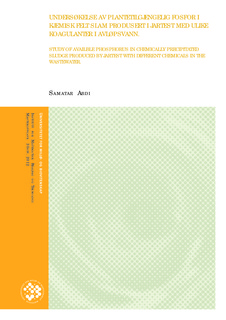| dc.description.abstract | Sammendrag
Bakgrunnen for oppgaven er å undersøke om kjemisk rensing av avløpsvann vil gi et slam med lett resirkulerbar og tilgjengeligfosfor til planter og for å bestemme den nødvendige dosering av den aktuelle koagulanten.
Mange renseanlegg i Norge er fortsatt basert på å fjerne fosfor ved å benytte fellingskjemikalier selv om de også kan ha biologiske rensetrinn. Kjemisk rensing av avløpsvann er den meste effektive metoden til reduserer fosforinnholdet.
Undersøkelse ble i hovedsak utført som jartest i Jord laboratorie på Bioforsk i 4 runder over en periode på 2 måneder.
Hensikten med disse undersøkelsene var å anvende jartester for rensing av avløpsvann ved bruk av ulike koagulanter.
I prosjektet ble det anvendt koagulanter under kontrollert forhold i Jartester for å rense avløpsvann for fosfor. Dernest ble samlet slammet analysert for ulike parametere spesielt med tanke på fosforets plantetilgjengelighet.
For å bestemme fosfor konsentrasjon er det utførte flere analyser av tørr slam, renset vann (supernatant), filtrat vann og ekstrakter. . Blant de målte parametere kan vi nevne pH, TOC, og konduktivitet.
Alle kjemikalier egner seg godt til å fjerne godt ortofosfater uansett doseringer. Oppnådd rensegrader god rensing ved kjemisk felling. Oppnådd rensegrad ser ut til å være tilfredsstillende med unntak av ALS og PIX311 ved lave doser. Dette er ikke overraskende, da råkloakkprøvene hadde lav ortofosfat konsentrasjon i utgangspunkt.
Resultatene viser at andel fosfor som er lett tilgjengelig er lavest i Al- felt slam, etterfulgt av Fe-felt. De siste nevnte slamtypene hadde også høy metall innhold, noe som gjør at mye av fosfor blir bundet til metaller og er lite tilgjengelig for planter.
Derimot viste kalk felling og en kombinasjon av kalk + sjøvann å være den rensemetode som gir mest tilgjengelig fosfor i følge resultantene mine.
Abstract
The goal for the task is to investigate whether the chemical treatment of waste water will give sludge with easily recyclable and available phosphorus to plants and to determine the required dosage of the appropriate coagulant.
Many treatment plants in Norway are still based on the removal of phosphorus using chemicals even though they may also have biological treatment stage. Chemical treatment of wastewater is the most effective method to reduce the phosphorus content.
The survey was mainly conducted as jartest in Soil Laboratory at Bioforsk building and takes 4 rounds in a period of 2 months.
The purpose of this research was to apply Jartester to wastewater treatment by using different coagulants.
This project is intended to apply the coagulants under controlled conditions in Jartester in order to purify wastewater for phosphorus. Then, sludge is collected and analyzed for various parameters, especially toward phosphorus plant availability.
To determine the phosphorus concentration in different samples it was performed several analyzes of dry sludge, purified water (supernatant), filtrate water and extracts. Several parameters are measured during the analysis and among these are the pH, the total organic carbon (TOC) and conductivity.
All chemicals turn out well to remove almost all of orthophosphate no matter of applied dosage. Having in mind the low orthophosphate level in the wastewater; this result doesn’t surprise anyone.
The achieved purification degrees in chemical precipitation appear to be quite sufficient except from ALS and PIX311 which indicate low treatment efficiency at low dosage.
The results show that the proportion of phosphorus that is readily available is the lowest in the Al-field sludge, followed by Fe-fields. The latter types of sludge had a high metal content, making that much of the phosphorus is bound to metals and is inaccessible to plants.
On the other hand, lime precipitation and a combination of lime seawater seem to be the best cleaning method which gives most available phosphorus according to my results. P-AL content in relation to the total phosphorus in the sludge is far above what was found in Al-and Fe-sludge field. | no_NO |
